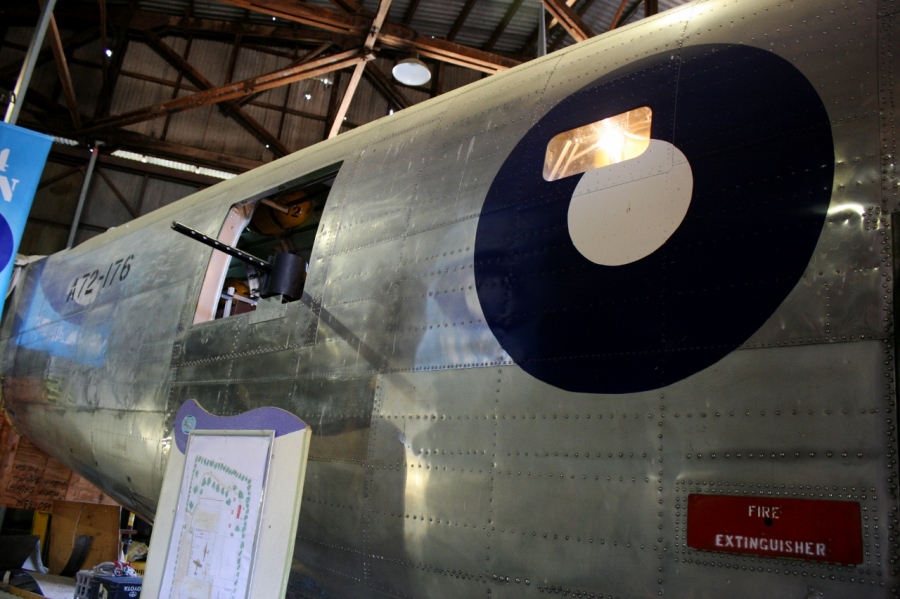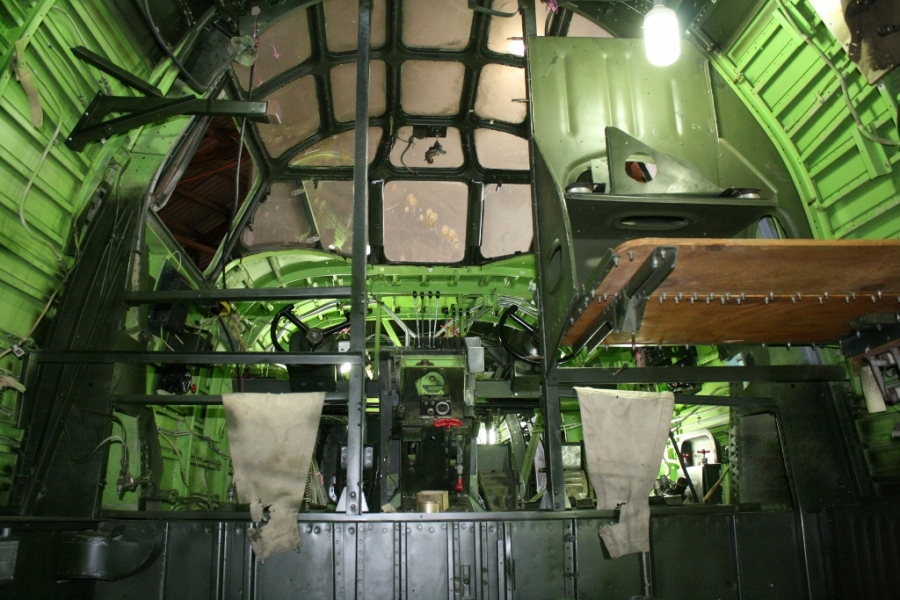In 2013 I wrote about the long-term project by the B-24 Liberator Memorial Restoration Fund (formed in 1989 and manned by a dedicated group of volunteers) in Werribee, Victoria to restore the last surviving Consolidated B-24 Liberator bomber operated by the Royal Australian Air Force (RAAF) in World War Two. This particular aircraft is a B-24M model (s/n 44-41956, RAAF serial number A72-176, delivered in late 1944) and is also the only B-24 in the southern hemisphere (there are only around 14 complete airframes surviving around the world today with a couple still flying in the USA).

The story of this aircraft being the last surviving RAAF B-24 Liberator is quite remarkable given 287 examples served in RAAF bomber squadrons No. 12, 21, 23, 24, 25, 99 and 102, along with No. 7 Operational Training Unit in Tocumwal, NSW which received the first 9 B-24’s in Australia in February 1944 (B-24D, B-24J, B-24L and B-24M models were operated by the RAAF). The Liberator was the only heavy bomber used in the Pacific by the RAAF and they operated from the Northern Territory, Western Australia, Morotai in the Netherlands East Indies and Palawan in the Philippines with the sad loss in combat of 33 aircraft and more than 200 crew. In 1948 the last B-24’s where retired by the RAAF and replaced by Australian-built Avro Lincoln bombers.

In February 2016 I revisited the restoration of the old girl in one of the World War Two hangars on the old Werribee airfield. Externally not much has changed on the B-24 airframe but much work has been done on the interior of the big bomber, along with work on various components of the aircraft.

A72-176 did not see combat, but was used by No. 7 Operational Training Unit at Tocumwal, NSW to train B-24 crews. It was later modified with the addition of a target tracking search radar in the lower fuselage and redesignated as a B-24R. At the war’s end most B-24’s were no longer required and were scrapped for their metal which was then melted down for more urgent use. So much metal was required for the war effort that once peace came it was put back into essential items for daily life from pots and pans to cars and the like. Luckily A72-176 avoided this fate an continued to be operated in various roles before its last flight to RAAF East Sale in 1946 where it remained as an instructional airframe until 1948.
The airframe was then sold as scrap at East Sale Airfield in March 1948 (minus its wings and tail that had already been scrapped) but ended up being used as a temporary home while the owner built his house on a farm near Moe, Victoria and eventually just left to its own course, exposed to the elements out in the open where it sat from the 1950’s to early 1990’s. Although negotiations to obtain the B-24 fuselage first began in 1989, an agreement with the farmer was not finalised until 1995!
Given there were no B-24 wings available in Australia one was located in Papua New Guinea in 1991 but had to be recovered from the jungle – The RAAF, Australian Army, Qantas, Shell and other companies stepped in to help out and successfully recovered the wing from a USAAF B-24D Liberator (serial number 42-41091) that crashed during World War Two. It was imported into Australia in 1992. Japanese bullet holes and shrapnel damage can be still seen in upper sections of the wing!
The majority of the airframe parts, equipment and engines for the restoration have been sourced from around Australia and the world, plus through generous donations. The volunteers worked on the wing while the fuselage deal was still being resolved.
The cleanup of the fuselage internally and externally began in 1996. After years of outdoor exposure a lot of restoration work was required to get it back to looking brand new! Work to re-attach the wing to the fuselage began in 2000.








Although the Liberator is being restored to its original appearance, it will not be to flight condition as it really is just too rare to risk. Instead it is intended that the B-24 will be capable of starting the engines up for taxiing purposes only and for it to displayed as a museum piece (four working Pratt and Whitney Twin Wasp 1830 engines plus a spare are being restored). It will have functioning systems throughout though, to meet the standard of a limited operational aircraft, hence the meticulous interior restoration work being undertaken.



An interesting side project in Werribee is the construction of an accurate twin-engine, three seat Airspeed Oxford replica. This type of aircraft was used for initial multi-engine pilot and crew training in the RAAF during and after the war. 391 were sent to Australia between 1940 and 1944 as part of the Empire Air Training Scheme (EATS), with the last retired in 1953. It is planned to fit the replica with two restored Armstrong Siddeley Cheetah 10 engines that will be in full operating condition. Much work is currently going on in the hangar to build the monocoque airframe and wings which are mostly made of glued and tacked timber and plywood wooden wings (not many originals survived hence the rebuild and replica status).





I discovered a surprise visitor in the old hangar. A local restoration project of a CAC Boomerang fighter is currently being held there and may possibly be displayed at the proposed museum which will be an expansion of the hangar at Werribee. The Boomerang was the first combat aircraft to ever be designed and built in Australia (the design basis was the locally developed CAC Wirraway trainer and utility aircraft derived from the North American Harvard / T-6 Texan). 250 were manufactured between 1942 and 1945.



Built in a time when the Japanese were threatening Australia’s northern shores and combat aircraft were in short supply, the CAC Boomerang was designed and built as an emergency fighter but unfortunately its top speed was only 490 kph / 305 mph and inadequate against faster Japanese fighters such as the Mitsubishi A6M Zero, especially at higher altitudes. Thus a new role was born for the Boomerang, that of low-level close support missions in places such as New Guinea. Armed with heavy hitting firepower of 2 x 20mm cannons and 4 x .303 machine guns, plus ruggedness, heavy armour plating protecting the pilot, good maneuverability and good performance at low altitude, the Boomerang proved very suitable to this role and earned great respect from the troops down below.

There are many aircraft restoration projects currently underway or recently finished in Australia (static and flying). It is great to see the warbird scene growing year after year and RAAF history being preserved for future generations. The B-24 restoration still has a long way to go but progress in recent years has been quite rapid. Slowly but surely they will get there!

Reblogged this on Travel for Aircraft and commented:
Dean has an update on the penultimate B-24 model–the B-24M–restoration as well as the only B-24 displayed in the southern hemisphere. As with most aircraft models weight creep affected later models but it affected the Liberator more than most since the wing was not enlarged. The M was lighter, though, than the previous L model in the effort to bring perfomance up. Read Deano’s, as usual for him, complete and eloquent report 🙂
LikeLiked by 2 people
Thanks Joe!
LikeLike
I mentioned as a child I flew in a regular service Avro Anson Casino to Mascot 1947! Living in Casino, during W W 2! B24 a/c landed at Evans Head also Casino, not real common. The ones I seen, operated by U S A Air force. One night radio 2LM Lismore sent out a message, ? , enemy planes sighted heard in Casino & Lismore, put all your lights out, pull the curtains across. The irony was Lost American crews, two crashed over Naughtons Gap, crews killed ( a war Secret) then Radio 2lm that night Urgent, if you own a car, race to Casino A/P turn your lights on to illuminate the runway. A remarkable story yes I am 80 yrs.Richard.
LikeLiked by 1 person
I have heard about the cars having to go out there. Crazy times Richard! Despite the wartime condition, I imagine it was boys own adventure stuff for you back in those days though?
LikeLike
G. BOUCHER, No 3 Flt., 8th Intake, N.S.T. Laverton, 1953! I was one of personnel to guard the Lancaster overnight when it landed earlier in the day at Laverton ! I believed it was ” G for George ” ! Our only protection from the extremely cold wind was uniform and great-coat under the enormous wing.
LikeLiked by 1 person
Doesnt sound like fun!
LikeLike
[…] B-24M A72-176 served with RAAF No. 7 Operational Training Unit at Tocumwal, NSW to train B-24 crews. At war’s end the airframe luckily survived the fate of many Liberators and avoided the scrap yard. It continued to be operated as a transport and for other roles, then following its final flight on March 26th, 1946 became Instructional Airframe No. 5 at RAAF East Sale until 1948 when it was sold to a farmer for scrap. The Werribee team obtained the fuselage in 1995 and began the long restoration process in 1996, in an old hangar at the former RAAF Werribee Aerodrome site that was built in 1940 for use by various RAAF units and used as a training field and storage/repair base. To read a more detailed history on the airframe and its restoration please take a look at my blog from my last visit in April 2016. […]
LikeLike
[…] 2016 […]
LikeLike